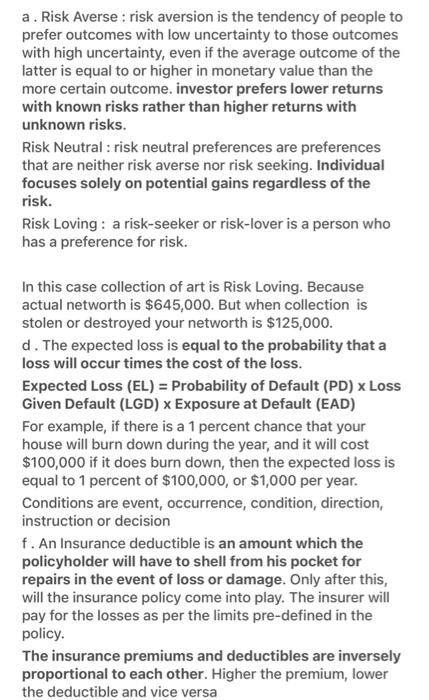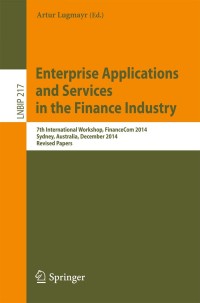Answered step by step
Verified Expert Solution
Question
1 Approved Answer
answers to a, d and f are provided. please answer b, c, and e 5. Suppose you have a collection of very modern art with
answers to a, d and f are provided. please answer b, c, and e 

5. Suppose you have a collection of very modern art with a net worth of $645,000. If your art collection is stolen or destroyed, your net worth is $125,000. Suppose you have a utility function over wealth that can be described by U=x2875, where x is your level of wealth. You figure there is a 0.75% (note: less than 1%) chance that your art collection will be stolen or destroyed in any one year. a. Are you risk averse, risk neutral or risk loving? Explain. (2 marks] b. What is the most insurance you would pay? [4 marks] c. What is the least amount an insurance company would have to charge each client like you in order to just break even (assuming zero over-head costs)? Over what range of prices can we expect a market for insurance to develop [2 marks] d. What conditions are necessary for an insurance company to focus on the expected loss? [2 marks] e. Explain why your insurance company might be happy to social media reflect stories to you that dwell upon the number of national and international art thefts every year. [3 marks) f. Explain why insurance companies charge a deductible - an extra fixed fee when a person submits a claim - and why the price of insurance is typically inversely related to the deductible. [2 marks] a. Risk Averse : risk aversion is the tendency of people to prefer outcomes with low uncertainty to those outcomes with high uncertainty, even if the average outcome of the latter is equal to or higher in monetary value than the more certain outcome. investor prefers lower returns with known risks rather than higher returns with unknown risks. Risk Neutral: risk neutral preferences are preferences that are neither risk averse nor risk seeking. Individual focuses solely on potential gains regardless of the risk. Risk Loving: a risk-seeker or risk-lover is a person who has a preference for risk. In this case collection of art is Risk Loving. Because actual networth is $645,000. But when collection is stolen or destroyed your networth is $125,000. d. The expected loss is equal to the probability that a loss will occur times the cost of the loss. Expected Loss (EL) = Probability of Default (PD) x Loss Given Default (LGD) x Exposure at Default (EAD) For example, if there is a 1 percent chance that your house will burn down during the year, and it will cost $100,000 if it does burn down, then the expected loss is equal to 1 percent of $100,000, or $1,000 per year. Conditions are event, occurrence, condition, direction, instruction or decision f. An Insurance deductible is an amount which the policyholder will have to shell from his pocket for repairs in the event of loss or damage. Only after this, will the insurance policy come into play. The insurer will pay for the losses as per the limits pre-defined in the policy. The insurance premiums and deductibles are inversely proportional to each other. Higher the premium, lower the deductible and vice versa 5. Suppose you have a collection of very modern art with a net worth of $645,000. If your art collection is stolen or destroyed, your net worth is $125,000. Suppose you have a utility function over wealth that can be described by U=x2875, where x is your level of wealth. You figure there is a 0.75% (note: less than 1%) chance that your art collection will be stolen or destroyed in any one year. a. Are you risk averse, risk neutral or risk loving? Explain. (2 marks] b. What is the most insurance you would pay? [4 marks] c. What is the least amount an insurance company would have to charge each client like you in order to just break even (assuming zero over-head costs)? Over what range of prices can we expect a market for insurance to develop [2 marks] d. What conditions are necessary for an insurance company to focus on the expected loss? [2 marks] e. Explain why your insurance company might be happy to social media reflect stories to you that dwell upon the number of national and international art thefts every year. [3 marks) f. Explain why insurance companies charge a deductible - an extra fixed fee when a person submits a claim - and why the price of insurance is typically inversely related to the deductible. [2 marks] a. Risk Averse : risk aversion is the tendency of people to prefer outcomes with low uncertainty to those outcomes with high uncertainty, even if the average outcome of the latter is equal to or higher in monetary value than the more certain outcome. investor prefers lower returns with known risks rather than higher returns with unknown risks. Risk Neutral: risk neutral preferences are preferences that are neither risk averse nor risk seeking. Individual focuses solely on potential gains regardless of the risk. Risk Loving: a risk-seeker or risk-lover is a person who has a preference for risk. In this case collection of art is Risk Loving. Because actual networth is $645,000. But when collection is stolen or destroyed your networth is $125,000. d. The expected loss is equal to the probability that a loss will occur times the cost of the loss. Expected Loss (EL) = Probability of Default (PD) x Loss Given Default (LGD) x Exposure at Default (EAD) For example, if there is a 1 percent chance that your house will burn down during the year, and it will cost $100,000 if it does burn down, then the expected loss is equal to 1 percent of $100,000, or $1,000 per year. Conditions are event, occurrence, condition, direction, instruction or decision f. An Insurance deductible is an amount which the policyholder will have to shell from his pocket for repairs in the event of loss or damage. Only after this, will the insurance policy come into play. The insurer will pay for the losses as per the limits pre-defined in the policy. The insurance premiums and deductibles are inversely proportional to each other. Higher the premium, lower the deductible and vice versa 

Step by Step Solution
There are 3 Steps involved in it
Step: 1

Get Instant Access to Expert-Tailored Solutions
See step-by-step solutions with expert insights and AI powered tools for academic success
Step: 2

Step: 3

Ace Your Homework with AI
Get the answers you need in no time with our AI-driven, step-by-step assistance
Get Started


